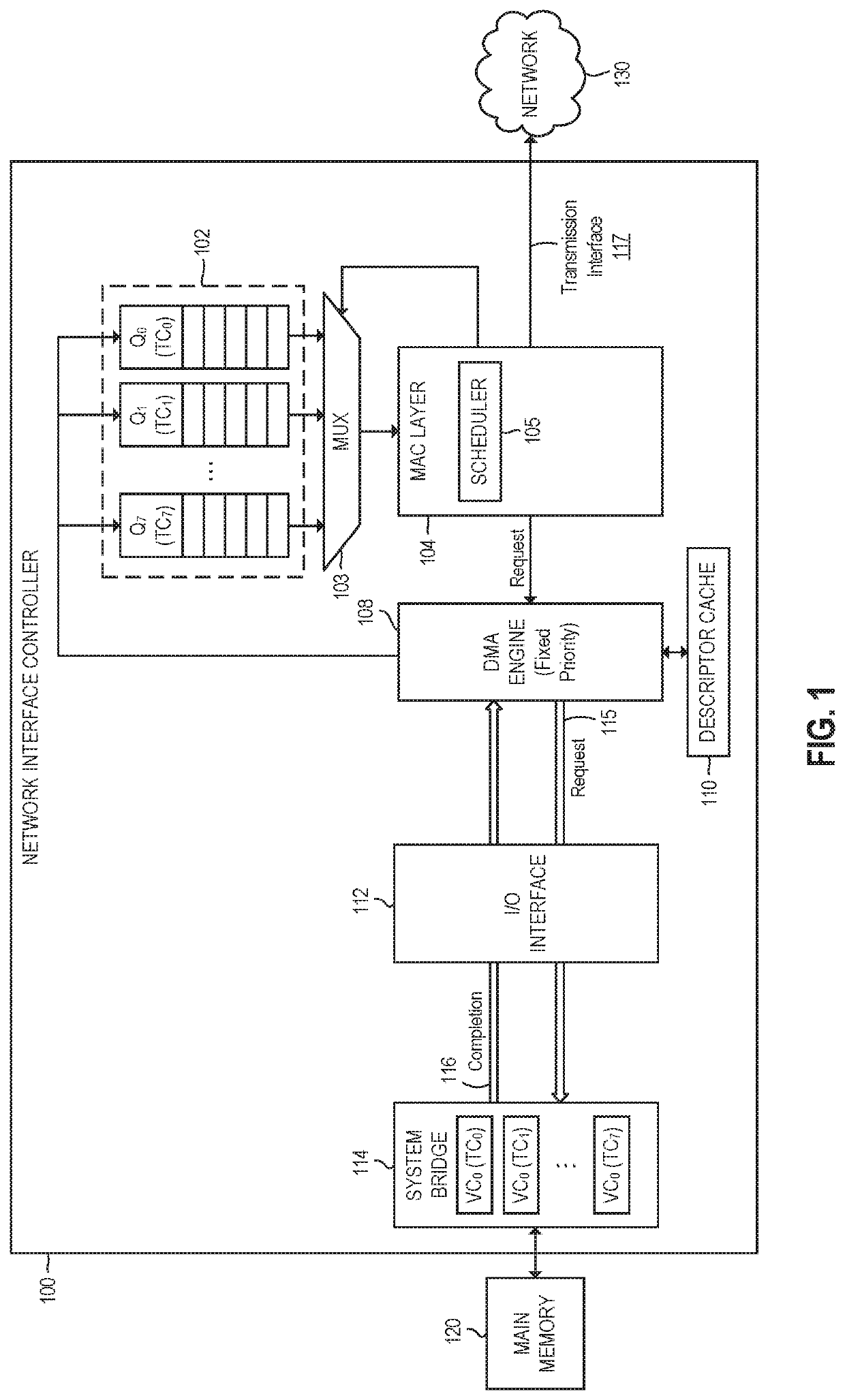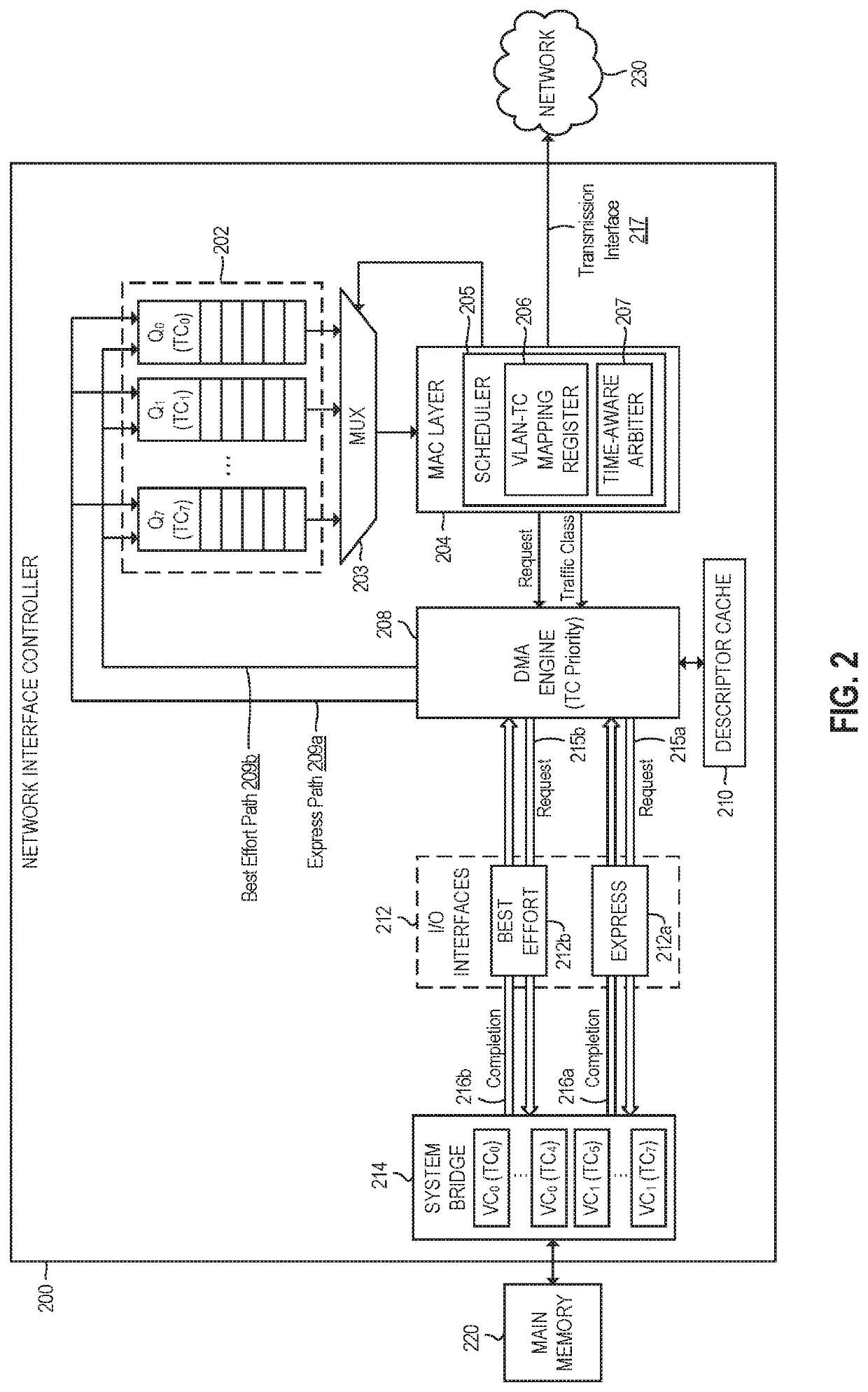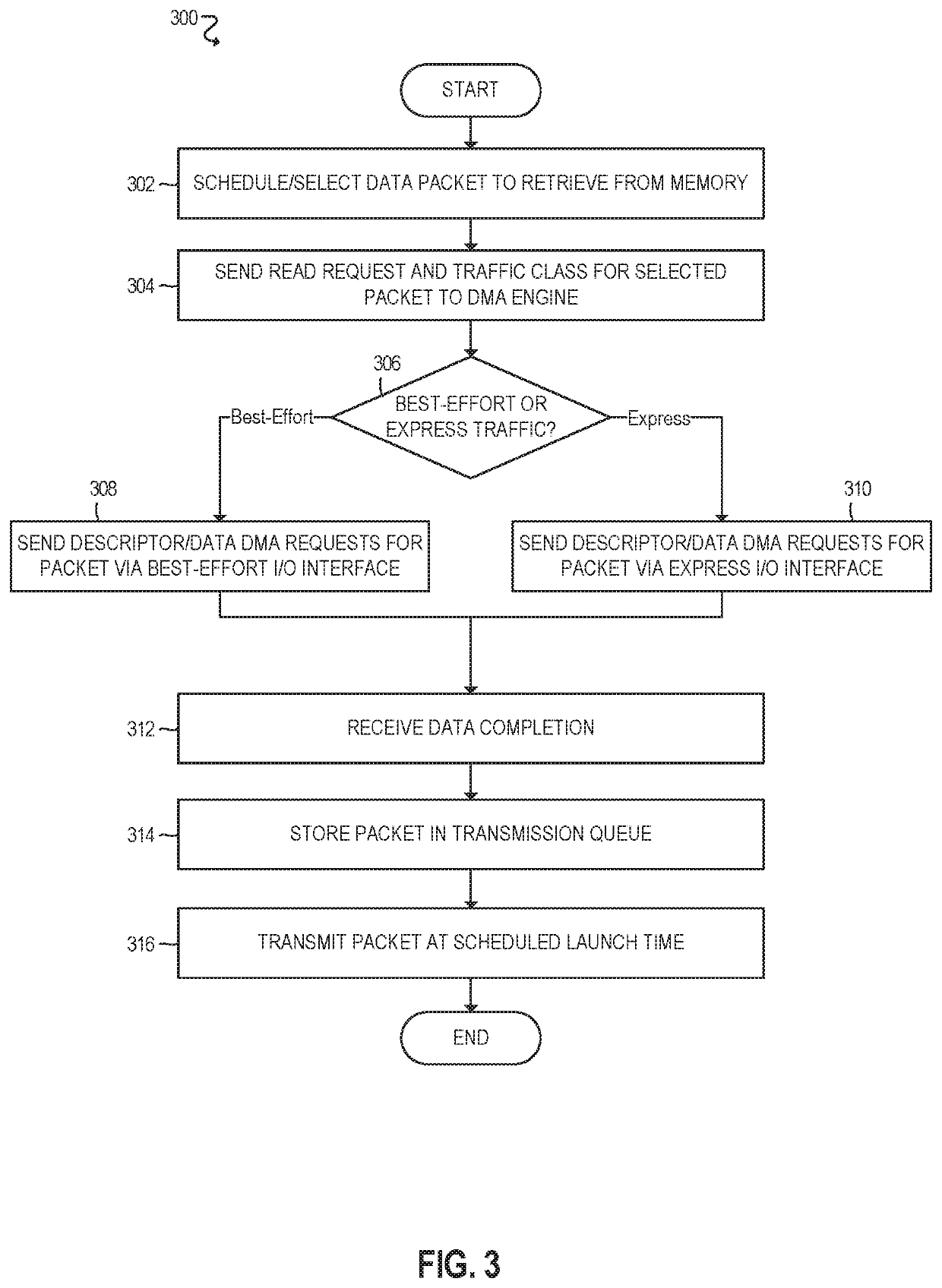The inevitable convergence of
Information Technology (IT) and Operational Technology (OT),
workload consolidation, and the demand for seamless communication across many connected devices, however, are imposing increasingly stringent requirements on
network performance, including higher bandwidth, shorter end-to-end latency, and hard real-time delivery requirements.
In some cases, however,
network interface controllers (NICs) are unable to satisfy these increasingly stringent requirements due to various design limitations.
As an example, the ability of a NIC to transmit a large burst of packets deterministically within a short period of time is limited by various factors, including the scheduling
algorithm(s) employed by the NIC (e.g., as defined in various IEEE TSN standards such as IEEE 802.1Qav and IEEE 802.1Qbv), the latency and
jitter associated with fetching packet descriptors and payloads from main memory via
direct memory access (DMA), the burst size (the larger the burst size, the higher the latencies incurred by the NIC), and the order in which the upstream DMA read requests are sequenced, among other factors.
The latency and
jitter associated with these DMA operations, however, can lead to packet transmission delays in certain situations, particularly when transmitting large bursts of packets.
While a NIC can leverage various priority-based scheduling schemes to help ensure that packets are transmitted in a timely manner (e.g., fixed priority, weighted strict priority, and
weighted round robin), these schemes are not always effective, as they lack awareness of packet launch times and traffic class priorities when the packet descriptors are prefetched from memory.
Thus, while these schemes provide some improvement in the scheduling of data packets for transmission on the wire, they are completely unaware of when to prefetch the descriptors for the packets, which renders them unsuitable for low-latency and hard real-time applications, particularly in situations when time-sensitive traffic is intermixed with best effort traffic.
For example, when transmitting a burst of packets, high-priority upstream read requests for
packet payload data can become blocked or stuck behind low-priority requests, thus leading to huge latency spikes and jitter.
For example, a NIC with 8 packet transmit queues that performs prefetching 16 entries deep into each
queue can generate 128 descriptor read requests, which can cause head of the line blocking for the actual
packet payload DMA requests.
Increasing the outstanding credits can improve the average bandwidth, but it will not help latency and
determinism because the
payload data DMA requests are still sequenced behind all 128 descriptor requests.
In addition, in current NIC architectures, access to the internal
queue buffers (e.g., RF memory) is single channel—thus, while writing low-priority completions into the queue buffers, the high-priority completions must wait, which further increases the
transmission latency.
As a result, the scheduler generates the descriptor read requests for all queues and traffic classes, which can create a latency bubble since the high-priority
packet payload requests are queued behind the descriptor requests.
While the head of the line blocking problem could potentially be addressed by extending the credit-based scheduling method to the descriptors (e.g., waiting for available credits before prefetching descriptors), that is not a viable solution, as it would significantly increase the overall packet
transmission latency (e.g., due to waiting for credits to become available, then fetching the descriptor, and then fetching the packet
payload data).
Thus, while this method improves control over when to launch packets, it does not address when to prefetch descriptors.
As a result, this method suffers from the same drawbacks as the other scheduling methods noted above.
While the methods above improve scheduling considerably, none of them address the head of the line blocking problem and associated latency spikes caused by descriptor prefetches.
The above methods primarily address
packet scheduling and launching with respect to the
payload data, meaning when to transmit the data packets on the line or wire, but they have no mechanism for intelligently prefetching descriptors (e.g., based on the traffic classes of the corresponding packets).
As a result, any low-priority request that is ahead of a high-priority request will block the high-priority request and cause a huge latency spike, which leads to indeterminism and increases the overall end-to-end latency.
Moreover, arbitration is only performed at the time of request
initiation, which means high-priority requests from express queues that come just after low-priority traffic requests get stuck behind in the queue waiting.
Further, increasing the number of credits will not help because a later scheduled high-priority request can still wait behind a prior scheduled low-priority descriptor request.
While that approach can significantly reduce the overall packet transmit latency, it requires substantial changes to the existing NIC hardware and NIC
software driver model.
Thus, network interface controllers suffer from various design limitations that render them susceptible to latency, jitter, and transmission delays in certain situations.
For example, as described further below, a single memory path is used for all traffic classes which leads to a
bottleneck, and a funneling effect due to the
crowding of read requests leads to grant
delay and eventually completion
delay for the requests, as high-priority requests may be waiting behind low-priority requests.
This fixed-priority scheme restricts applications, however, as dynamic assignment of traffic to the queues is not possible—the ability to dynamically assign traffic to queues is particularly important for applications in dynamic environments, such as industrial applications where workloads constantly change as field devices are added or go down (e.g., fail).
In particular, while the purpose of descriptor prefetching is to reduce end-to-end latency, there is a
side effect that can occur when a burst of back-to-back data contains hard real-time traffic intermixed with low-priority traffic, as the real-time requests can sometimes get stuck behind the low-priority requests and incur huge latency spikes.
The concept of prefetching significantly helps improve overall bandwidth, and this scheme can be used when there are some guard bands around real-time traffic, but it is not well suited for back-to-back burst traffic.
In some cases, however, the latency and jitter associated with these DMA operations can lead to packet transmission delays.
The use of a single DMA engine for an intermix of time-sensitive transactions and non-time-critical transactions will lead to large latency spikes, however, which can be highly problematic for time-sensitive applications (e.g., real-time industrial applications).
As a result, the time-sensitive packet data requests have to wait for the previously scheduled descriptor requests to be granted, and those packet data requests will simply wait in the
request queue until they are eventually granted, which leads to additional packet latency and jitter.
Thus, while the purpose of descriptor prefetching is to increase
bandwidth utilization and reduce end-to-end latency, the current approach is only effective for a single queue, as various side effects can occur when descriptor prefetching is used with multiple time-critical queues.
For example, due to the intermixing of descriptors with data packet payload requests, sometimes time-sensitive data payload requests may get stuck behind low-priority (e.g., best-effort) data packet and descriptor requests, which can severely
impact packet transmission latencies.
While this channel separation technique can greatly reduce the interference from best-effort traffic, there can still be unintended interference among the respective express traffic requests.
For example, a descriptor request from one express queue can get well ahead of a packet
data request from another express queue, which can cause large latency spikes.
Thus, the use of multiple traffic classes and virtual channels (e.g., as described above in connection with NIC 200 of FIG. 2) can reduce these latency spikes to some extent, but it does not eliminate them.
However, since multiple time-sensitive queues may be assigned to the same traffic class and / or
virtual channel, there is still a risk of a latency spike, as the descriptor prefetching for one time-sensitive queue could intermix with the packet payload fetching for another time-sensitive queue.
As a result, the packet payload transaction has to wait until the descriptor prefetch is granted, thus incurring additional latency.
Thus, while having separate request queues for best effort and express traffic will improve latency significantly, it is still susceptible to large latency spikes.
Thus, even though the best-effort traffic requests are separated from express traffic requests, the descriptors and packet data in the various express packet queues still must share the same
request queue, which eventually leads to unintended latency spikes.
While these DMA and scheduling techniques provide considerable latency improvements, none of them address the latencies that result from certain DMA operations, such as descriptor prefetching and the intermixing of descriptor prefetch requests with packet data requests.
While this approach is supported by the embodiments described throughout this disclosure, the major
disadvantage of this approach is increased area cost and die size.
In addition, the SoC may not have enough virtual channels to support unique per-queue assignments, as many current SoCs only support two virtual channels (VC0 and VC1).
Further, this approach is not scalable for applications that require a large number of queues, as there are only 8 traffic classes defined in the IEEE 802.10 standards.
For example, there will be large inter-packet gaps due to the latencies associated with the SoC, thus preventing the full
line rate from being achieved.
This is a major limitation for applications where the full
line rate is needed and when there is a large volume of best-effort traffic for non-real-time applications.
Since packet data fetching is extremely
time critical, however, a separate DMA engine handles these transactions and will
route the transactions based on the traffic class and time priority.
While the
Time Sensitive Networking (TSN) standards define algorithms for precise scheduling of a packet, there are no standardized methods defined for precise, real-time monitoring of the transmit latency and
launch time jitter of a packet.
However, these RMON counters only monitor generic network statistics (e.g., general
Ethernet LAN statistics)—they do not monitor the TSN specific real-time packet latencies and jitter associated with TSN packet transfers, nor do they count or track the packets that violate the stipulated
launch time.
Thus, there is currently no standard mechanism to monitor packet latencies and jitter precisely in real time when a time-critical application is running.
The existing RMON counters are for generic
Ethernet-based statistics and not suited for TSN applications.
These synthetic workloads and
test procedures, however, are not performed in real time, they are inaccurate, and they cannot guarantee whether the
system is meeting hard real-time requirements.
There are several issues with this approach.
First, the packet latency is measured using a synthetic
workload and synthetic test procedure, which is not identical to customer infield applications.
The real-time packet latencies are greatly affected by the
workload, interference, and real-time traffic patterns, but it is often difficult to reproduce the customer real-time failures in the lab.
Also, since several resources are shared (e.g., CPU core, memory / cache, fabric), these synthetic tests will not provide accurate measurements of packet latencies.
Second, the measurement is done from the
tail pointer update, which is highly inaccurate for two reasons.
By doing this, the packets will now be transmitted infrequently, and latencies associated with back-to-back packet pressure, head-of-the-line blocking, limited availability of outstanding credits, limited prefetch cache, and several other hardware specific limitations are not considered.
As a result, the measurements provide overly optimistic latency values, which makes it difficult to catch or identify the outliers.
As a result, there is some discrepancy between the clocks that needs to be accounted for.
Due to these issues, the current methods are inaccurate and cannot guarantee the level of accuracy or reliability required for very low
cycle time and hard real-time industrial applications (e.g., nine 9's of accuracy, or 99.9999999%).
Thus, there are no known solutions available for monitoring hardware specific real-time latencies and jitter at runtime.
The best-effort traffic is used for non-time-critical traffic and the latencies are not guaranteed.
The devices located at the edge are often resource constrained and therefore there is pressure on usage of edge resources.
There may be inherent power-performance tradeoffs in these pooled memory resources, as many of them are likely to use emerging memory technologies, where more power requires greater
memory bandwidth.
 Login to View More
Login to View More  Login to View More
Login to View More 


